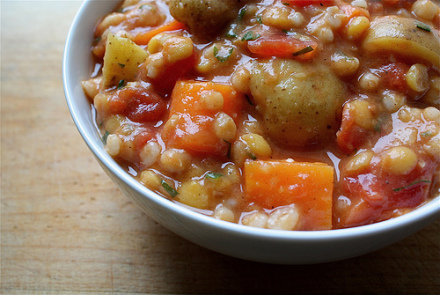A pleasing mixture of textures and flavours
 Tuesday, March 10, 2009
Tuesday, March 10, 2009 After I rediscovered barley's great flavour and versatility a few weeks ago, I began searching through my favourite cookbooks for recipes featuring this grain. When I turned to Persian Barley & Split Pea Stew in this Moosewood book, I stopped looking. "Now here's something different from the usual barley and mushroom combination," I thought. And it also met the criteria I'd set for the next new recipe-to-try: #1) a mixture of grains, legumes and vegetables, #2) simple -- not necessarily fast-to-make, but needing only basic tools & skills and one or two pots, #3) adaptable to making in stages, and #4) most if not all ingredients on-hand in the pantry or cold storage (fridge, freezer, or, make-shift "root cellar" on the balcony). This past weekend, all the necessary ingredients, including time, energy and concentration, converged in a pleasant afternoon cooking session and a tasty Sunday dinner...

Persian Split Pea & Barley Stew
... A comforting, hearty meal on a March day when the weather sharply shifted from lamb-like to leonine, and my thoughts turned from seed-sowing to protecting the balcony plants from freezing. The next day, a snow-day and a rare Monday off work for me, I enjoyed leftovers at lunch. I also put in the freezer several future meals for busy days. Yes, I agree, fresh is best, but because of my work hours, I need ready-to-serve meals that I can turn to when time, inspiration and energy are running on empty. (I worry a bit about confessing these things. I hope you won't be shocked or disappointed to know I don't cook from scratch everyday.)
Now, on to the recipe. I'm sharing the classic version as published with my modifications in {curly brackets}.
PERSIAN SPLIT PEA & BARLEY STEW
This combination of grains, legumes, and vegetables offers a pleasing mixture of textures. The barley adds chewiness and the yellow split peas help to thicken the flavorful vegetable stock. The currants and sweet spices nicely offset the tanginess of the lemon and yogurt
STEW
1/2 cup raw barley
1 bay leaf
1 large garlic clove
4 cups water
1 cup dried split yellow peas
1 teaspoon ground cardamom
1/2 teaspoon cinnamon
1 cup coarsley chopped onion
1 cup carrots, peeled and cut into 1-inch chunks
2 cups potatoes, cut in 1-inch chunks
1 1/2 teaspoons salt
1 pinch cayenne
2 cups vegetable stock
2 cups coarsely chopped tomatoes
2 tablespoons currants
1/4 cup minced fresh parsley
2 tablespoons fresh lemon juice (about 1 lemon)
salt and ground black pepper to tasteGARLIC YOGURT (optional)
1/2 cup nonfat yogurt
2 minced small garlic cloves
pinch of salttoasted pine nuts (optional)
lemon wedges (optional)
- In a medium saucepan, bring the barley, bay leaf, garlic and 2 cups of water to a boil.
- Reduce the heat, cover and simmer for 15 minutes. {In the morning, I cooked the barley in a rice-cooker.}
- Add the split peas, cardamom, cinnamon and the remaining water and simmer, covered for another 45 minutes, or until the barley and split peas are soft and most of the liquid has absorbed. {While the barley was cooking, I cooked the split peas & seasonings in a separate pot.}
- Stir occasionally and, if necessary, add a small amount of additional water to prevent the mixture from sticking. {I combined the cooked barley and split peas and set them aside in the fridge until late afternoon when I continued with the next steps.}
- While the barley and split peas are cooking, place the onions, carrots, potatoes, salt, cayenne, and stock in a large saucepan.
- Bring the mixture to a boil, reduce the heat and simmer, covered for 10 minutes.
- Stir in the tomatoes and continue to simmer, covered, for about 10 minutes, until the vegetables are tender.
- Add the cooked barley and split peas. Stir in the parsley, lemon juice, and salt and pepper to taste. Discard the bay leaf.
- If desired, combine the garlic yogurt in a small bowl. Sprinkle on a few toasted pine nuts and serve with several lemon wedges or a dollop of garlic yogurt.
Nutrient analysis (without optional ingredients) based on 6 servings; serving size about 500 mL (2 cups)
Calories (kcal) 264.9 Folate (μg) 139.6 Fat (g) 1.6 Vitamin B6 (mg) 0.3 Protein (g) 14.1 Vitamin B12 (μg) 0.1 Carbohydrate (g) 51.7 Calcium (mg) 109.1 Sugar (g) 11.2 Iron (mg) 4.4 Fibre (g) 7.4 Sodium (mg) 1105.1 Vitamin A (μg) 457.6 Potassium (mg) 972.6 Vitamin C (mg) 30.1 Vitamin D (μg) 0 Vitamin E (mg) 1.3 Thiamin (mg) 0.4 Riboflavin (mg) 0.2 Niacin (ne) 7.2
Source: Dietitians of Canada's Recipe Analyzer.
Canada's Food Guide/Vegetarian Food Guide evaluation: A 500 mL (2 cup) portion provides about 1 serving of high-fibre grains, 1 serving of low-fat meat alternatives/legumes, nuts, other protein-rich foods, and 2 servings of vegetables. The yogurt provides a partial serving of milk products/calcium-rich foods.
Rating: 5 stars for so many good things in one simple stew: flavourful, nutrient-rich, economical, easy-to-make and slow. Time at the stove, stirring the aromatic ingredients, was a pleasure that preceded the joy of eating.
 8 Comments | |
8 Comments | |  Permalink | tagged
Permalink | tagged  Recipes,
Recipes,  barley,
barley,  grains,
grains,  high-fibre,
high-fibre,  low-fat,
low-fat,  one-pot meals,
one-pot meals,  pulses,
pulses,  stew,
stew,  vegan
vegan